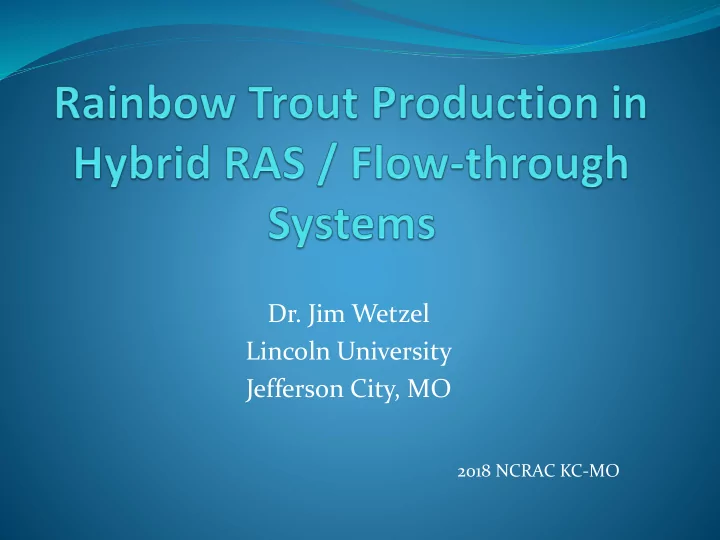

Dr. Jim Wetzel Lincoln University Jefferson City, MO 2018 NCRAC KC-MO
New Aquaculture Directive Diversify species options More applied More demonstration Increase our experience Processing Marketing Sales ($$$) to offset operating costs Lower tech capitalizing on Missouri resources Research resources Skin in the Game
Emphasize Food-fish Rainbow Trout
Rainbow Trout Markets Recreational Stocking Food-fish Optimal Environment Coolwater Relatively Constant Spring temperature Missouri
Applied Production Methods Simple Realistic harvest regimen Predictable Year round Staggered batches Regular sales steady cash flow Try to control cost Mistakes Past we learned from Will make plan to make more!
Take Into Account Challenges Entrepreneurs Face Goal: More Viable Producers
Water Availability Most larger springs spoken for Smaller springs more abundant Too small to support economically viable flow-through raceways Potential for : Summer cooling Winter heating Moderating changes
Recirculating Aquaculture Systems (RAS) Great for research because of control If indoors Conserve water very well Lots of parts Parts can range greatly in price >$20,000 to build a system Filtration / particulate removal biggest expense Power requirements high “ Flow Tuning ”
Combining RAS with Small Spring Water availability less of an issue Energy Technical Expertise Basics like how to feed Labor Costs Benefactors likely to have real jobs
Take Into Account Challenges Entrepreneurs Face Water availability Energy Technical Expertise Basics like how to feed Labor Costs Most have real jobs
Our Approach
Two RAS’s of Interest 9 culture units / each 210-gallon Food grade Plumbed in parallel External standpipe Internal standpipe
Self-cleaning Culture Tank Cylindrical with conical bottom (picture) Water flow rate and fish activity interactions Spin Disturbance
Filtration Solids Sump / settling chamber Bead filter (20 lbs feed / day) Manual vs. automatic Labor Leaching
Filtration Solids Sump / settling chamber Bead filter (20 lbs feed / day) Manual vs. automatic Labor Leaching Biological Mineralization of organic compounds Nitrification (NH 3 to NO 3 ) Submerged fluidized media (13 to 26 lbs feed / day) Aggressive aeration (10 cfm)
Circulation Pump Appropriately sized Single-phase 2 speeds Low – 45 minute residence time* High – 15 to 30 minutes residence time Pre-filter removed
Water Inlets Flow rate needed varies Fish size Stocking density Stepwise changes Control using nozzle / nipple size Volume impacted by head within line feeding it Angle of flow impacting water Imparts spin Visibility Long-term Flow
Aeration / Oxygenation O 2 ≥ 7 ppm Feed intake O 2 > 5 ppm Health issues Air pump Variable speed Air Diffusers Capacity for using liquid oxygen Will be additive
Aeration / Desaturation Ground water supersaturated Possible intake of air into pump N2 gas bubble disease Appetite loss Fish flashing Very little over saturation required to cause problems 2 % New problem for us Temperature impacts
Develop and Implement Protocol Stocking at 28-day intervals 2” fingerlings Feeding system (6 days per week) Automatic belt feeder w/ hand feeding Adjust feed size and amounts for apparent satiation Feed beginning and end of day Adjust for stock growth Culture tank flow System water replacement Air flow / oxygen flow Circulation pump adjustments Filtration (solids)
Protocol (continued) Ramping system up Cycling biofilter Periodic harvesting Stable “load” on filtration Health management Disease treatments External parasites Salt / formalin treatment Watch for system induced issues Harvesting Processing Sales
Status 4 months into production Culture tank flow adjustments Water (90 to 30 minutes residence time) Air / diffuser management critical Feed conversion ratio range 0.9 to 1.0 Smaller fish better Growth Growth pushing 2” / month 10” Target size 14.25” or 1.25 lbs >100 lbs / culture tank every 7 months
Status (continued) Biomass currently 20% peak Solids removal becoming an issue Currently solved by increasing labor Siphoning (not practical) Bead filter backflushing frequency adjustments Biofiltration keeping pace Oxygen levels in culture tanks will be a problem Experience with complete 12 hour power failure 30 minutes too long for 10” fish Simple oxygen diffusers will not work Trout behavior issue
Next Year: Knowledge Transfer Feeding fish Simple and effective When to make adjustments Fish behavior / health Water quality Solids (ideally based on feces) Production estimates*** Labor System cost Cost of production estimate
Acknowledgements North Central Aquaculture Center Missouri Aquaculture Association USDA-NIFA Lincoln University Tyler Edwards Cindy Borgwordt Greg Dudenhoeffer Marvin Emmerson – Crystal Lake Fisheries Dennis and Merrit – Troutdale Fish Farm
Recommend
More recommend